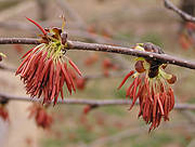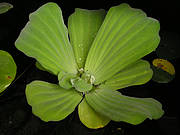Asia: The state of plant conservation
28.10.10
The International Union for Conservation of Nature (IUCN) have launched an important new report from the faltering Nagoya biodiversity conference. The First Asian Plant Conservation Report takes an in-depth look at the progress towards the Global Strategy on Plant Conservation (GSPC) on the vast continent.
 The 66 page report outlines the key features of plant diversity in Asia which it suggests is driven by "complex topography, diverse climate, and old biotic history" and has resulted in massive levels of endemism (including over 100 endemic families).
The 66 page report outlines the key features of plant diversity in Asia which it suggests is driven by "complex topography, diverse climate, and old biotic history" and has resulted in massive levels of endemism (including over 100 endemic families).
Euptelea pleiosperma (Eupteleaceae) from a monotypic family endemic to Asia. © Institute of Botany, Chinese Academy of Sciences
It highlights the extraordinarily diverse Kalimantan (Indonesian Borneo), where 6,000 of the 15,000 plant species are endemic, and the island of Sumatra where 218 species of vascular plants were found in 200 square metres. Endemism is one of the main criteria of the Hotspot system first put forward by Norman Myers in the 80s and it's worth noting that of Conservation International's 34 Biodiversity Hotspots, 10 are found in Asia.
 Major threats to plant diversity in Asia including habitat fragmentation, over-harvesting of natural resources, expansion of economic plants (such as oil palm and jatropha), pollution, invasive species and climate change.
Major threats to plant diversity in Asia including habitat fragmentation, over-harvesting of natural resources, expansion of economic plants (such as oil palm and jatropha), pollution, invasive species and climate change.
Pistia stratiotes (Araceae), one of the worst Invasive Alien Species. © Institute of Botany, Chinese Academy of Sciences
The expansion of oil palm plantations, particularly, is well documented and as well as impacting plant communities the growth has had dire consequences for people dependent on the forest while increasingly endangering animals such as orangutan and Sumatran tiger.
“This incredible effort from Asia has demonstrated the strength of setting targets for conservation,” says Jane Smart, Director, IUCN Biodiversity Conservation Group. “Much more has been achieved than would have been the case without such targets in place. IUCN now calls on this important work to be ‘brought to life’ to inspire governments and civil society across the region to do more for plants – the basis of all life on earth.”
As negotiations in Nagoya seem to be faltering under the same weight of bureaucracy that crippled last year's climate talks in Copenhagen, progress on ratifying the updated GSPC would be a considerable step.
The GSPC consists of 16 ambitious targets under five major items:
1. To understand and record plant diversity
2. To conserve plant diversity
3. The sustainable use of plant diversity
4. To promote the education of plant diversity
5. To establish organisations focusing on plant diversity
Download the full report (pdf)
Related links:
Japan: Conservation organisations take opportunity to speak out
22.10.10
![]() As delegates from around the world convene in Nagoya, Japan in an effort to find a route out of the biodiversity crisis, conservation organisations are using this opportunity to tell their stories.
As delegates from around the world convene in Nagoya, Japan in an effort to find a route out of the biodiversity crisis, conservation organisations are using this opportunity to tell their stories.
Global: Implementing GSPC Target 8, a report by BGCI
20.10.10
 On the second day of COP10 in Nagoya, Japan Botanic Gardens Conservation International (BGCI) have published a report reviewing progress in 2010 towards target 8 of the CBD’s Global Strategy for Plant Conservation (GSPC).
On the second day of COP10 in Nagoya, Japan Botanic Gardens Conservation International (BGCI) have published a report reviewing progress in 2010 towards target 8 of the CBD’s Global Strategy for Plant Conservation (GSPC).
Japan: Honest, but optimistic, opening statement by Ahmed Djoghlaf
19.10.10
As 16,000 representatives from more than 190 countries gather in Nagoya, Japan for one of the most important meetings in history, the man in charge of keeping the good ship biodiversity afloat has issued an opening statement.